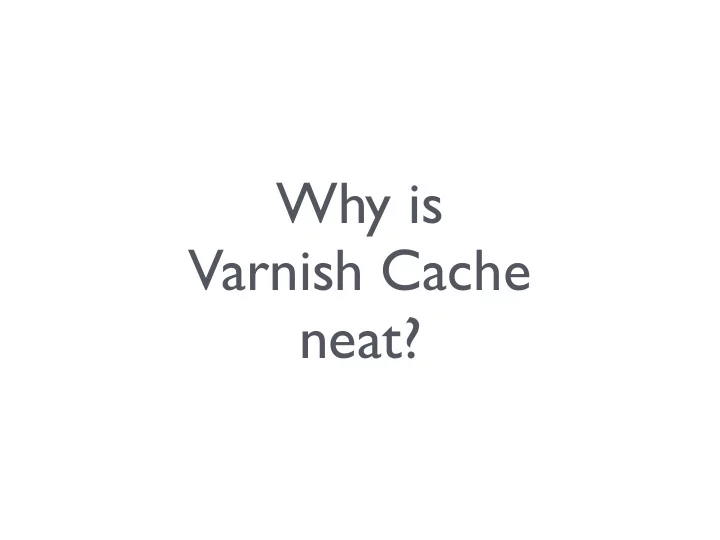

Why is Varnish Cache neat?
Who am I? • Per Buer • CTO @ Varnish Software • Programmer • Sysadmin
Varnish Software • We sell Varnish Plus • Products (clustering, scalability, etc) • Support • Custom development • Other software built on Varnish
What is Varnish? • Cache it? • Transform it? • Reject? • Auth? Authz? Web Client Varnish server
Q: Why do we cache? A: <40µs TTFB (vs 40ms)
Design • A HTTP server with HTTP backend • Threaded architecture • Logs to shared memory - weird, right?
VCL • Varnish Configuration Language • Gets compiled into binary code (.so), loaded and run
Varnish doesn’t support purging of content … out of the box
Purging content (1/2) sub vcl_recv { if (req.method == "PURGE") { return (purge); } }
Purging content (2/2) acl purge { "localhost"; "192.168.55.0"/24; } sub vcl_recv { if (req.method == "PURGE") { if (!client.ip ~ purge) { return(synth(405,"Not allowed.")); } return (purge); } }
Adding a “feature” to Varnish
Throttling hot linking • Hotlinking is unlawfully using resources from other servers in your own content • In this example we put a cap on the number of times per minute this can happen • Leverages a VMOD - “vsthrottle” to add throttling
import vsthrottle; (..) if (req.url ~ "^/assets/" && (req.http.referer !~ “^http://www.example.com/“) && vsthrottle.is_denied(req.url, 10, 60s) { return(error(403,“Hotlinking prohibited”); }
Things you should know • Varnish will not cache content requested with cookies • Solution: Strip the cookie • Tip: The cookie VMOD makes this easy
import cookie; sub vcl_recv { cookie.parse("cookie1: value1; cookie2: value2"); cookie.filter_except("cookie1"); // get_string() will now yield // "cookie1: cookie2: value2;"; }
More things to know • Set-Cookie headers deactivate cookies • Solution: Remove Set-Cookie or fix the backend
Grace mode
Grace mode • Allows Varnish to server outdated content if new content isn’t available • Content will be refreshed asynchronously from the backend increasing performance
sub vcl_backend_response { set beresp.grace = 2m; }
Opening the hood
sub vcl_hit { if (obj.ttl >= 0s) { // A pure unadultered hit, deliver it return (deliver); } if (obj.ttl + obj.grace > 0s) { // Object is in grace, deliver it // Automatically triggers a background fetch return (deliver); } // fetch & deliver once we get the result return (fetch); }
Modifying grace semantics
sub vcl_hit { if (obj.ttl >= 0s) { // A pure unadultered hit, deliver it return (deliver); } if (!std.healthy(req.backend_hint) && (obj.ttl + obj.grace > 0s)) { return (deliver); } // fetch & deliver once we get the result return (fetch); }
A couple of things you might wonder about…
What’s beresp? • req is the request object - use in vcl_recv • bereq is the backend request object - use in vcl_backed_fetch • beresp is the backend response - use in vcl_backend_response • resp is the response object - use in vcl_deliver • obj is the original object in memory - use in vcl_hit • “ man(7) vcl ” for details
The state machine
hit receive synth deliver miss backend error backend backend fetch response
What about tuning?
Quick guide to tuning on Linux • Up somaxconn and tcp_max_syn_backlog • Don’t mess with tcp_tw_recycle • Be aware of workspaces • Don’t do connection tracking • Up the threads - 1req/sec per thread
Bonus content
Redirection sub vcl_synth { if (resp.status == 750) { set resp.http.Location = "http://" + req.http.host + req.url; set resp.status = 301; return(deliver); } }
# invoking a redirection sub vcl_recv { if (req.http.host == "dev.example.com") { if (req.url ~ "^/archives/") { set req.url = regsub(req.url, "^/old/(.*)", "/archive/\1"); set req.http.host = “example.com"; return(synth(750, "Moved permanently")); } } }
Ideas not covered in this talk • shared memory logging in Varnish • bans: asynchronous filter expressions to mass-invalidate based on arbitrary input • “soft bans”: invalidate object but retain in memory • auth/authz in VCL - cryptography • playing with hashing vs Vary
foo service directory zoo bar baz
foo zoo bar varnish quux baz
Thanks! @perbu @varnishcache
Recommend
More recommend